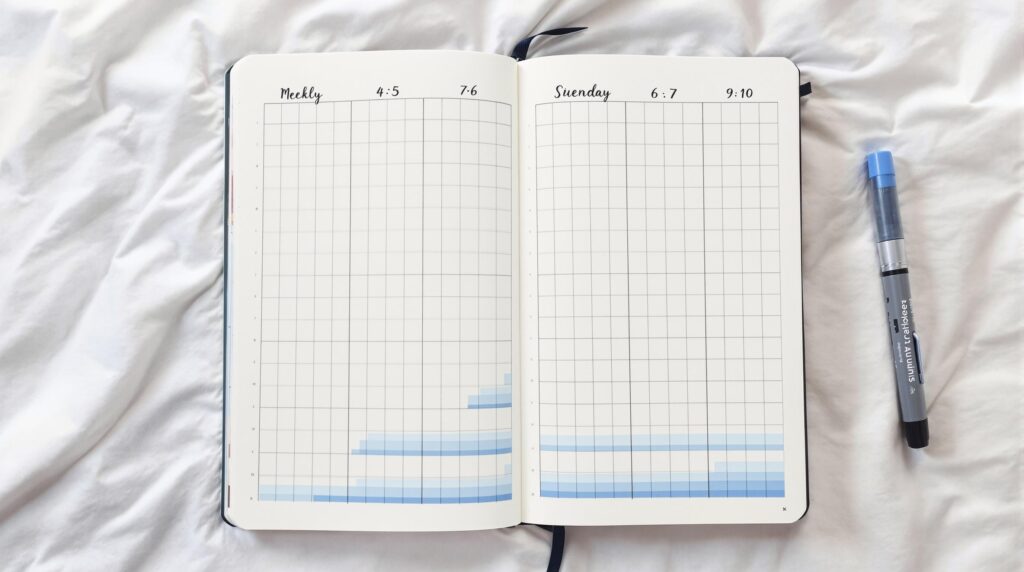Sleep is more than just a daily necessity—it’s a cornerstone of physical and mental wellbeing. Research from the Sleep Foundation shows that adults who regularly monitor their sleep patterns are 30% more likely to make positive sleep habit changes. Just as a mirror reflects your physical appearance, a sleep tracker bullet journal reflects your sleep health, providing clear visual feedback on this vital aspect of your life.
Creating a sleep tracker in your bullet journal gives you the power to identify patterns, make connections between your habits and sleep quality, and take control of your rest. This article will guide you through 10 creative sleep tracker bullet journal layouts that range from simple to artistic to data-rich, helping you find the perfect design for your journaling style.
Why Use a Sleep Tracker Bullet Journal Layout
Before diving into creative designs, let’s understand why tracking sleep in your bullet journal is worth the effort. A study published in the Journal of Sleep Research found that self-monitoring sleep behaviors led to improved sleep quality in 68% of participants. This happens because, much like looking in a mirror helps you notice details about your appearance you might otherwise miss, your sleep tracker bullet journal reveals patterns in your rest that might otherwise go unnoticed.
For instance, you might discover that you consistently sleep better on days when you exercise, or that afternoon coffee affects your sleep more than you realized. The act of recording also creates accountability—when you know you’ll be logging your sleep data, you become more mindful of your bedtime routines.
Additionally, the physical act of coloring, writing, or marking your tracker creates a moment of reflection about your sleep health that digital trackers often lack. This analog experience helps forge stronger mental connections with your sleep patterns and encourages more consistent tracking.
Essential Elements of an Effective Sleep Tracker Bullet Journal
An effective sleep tracker bullet journal layout should capture key metrics that provide a comprehensive view of your sleep health. Think of these elements as the frame of your mirror—they create the structure that allows clear reflection. The most useful trackers typically include:
- Sleep duration – Total hours slept each night
- Sleep quality – Subjective rating of how well you slept
- Bedtime and wake-up time – Tracking consistency in your schedule
- Environmental factors – Room temperature, noise levels, light exposure
- Pre-sleep activities – Screen time, reading, meditation, etc.
Research from the American Academy of Sleep Medicine suggests that tracking at least three of these elements provides enough data to identify meaningful patterns. When designing your tracker, choose the metrics most relevant to your sleep goals, then build your layout around them.
Simple Sleep Tracker Bullet Journal Designs for Beginners

If you’re new to bullet journaling or prefer minimalist layouts, these simple sleep tracker bullet journal designs offer function without overwhelming detail.
Weekly Grid Sleep Tracker Bullet Journal Layout
The weekly grid is a perfect starter sleep tracker bullet journal design. Create a 7×7 grid with days of the week along one axis and hours of sleep (4-10) along the other. Each day, color in the appropriate box to indicate how many hours you slept. This compact design fits easily on a single page and provides a clear visual of your sleep duration patterns throughout the week.
For added functionality, use different colors to rate sleep quality, or add small icons below each day to note factors that might have affected your sleep (exercise, caffeine, stress, etc.). The beauty of this simple design is that it takes less than a minute to fill in each day but still yields valuable insights.
Monthly Calendar Sleep Tracker Bullet Journal
This layout transforms a traditional monthly calendar into a sleep tracker bullet journal by adding sleep data to each date square. For each day, note your bedtime, wake time, and total hours in the corner of the corresponding date box. Then color the box based on sleep quality: for example, blue for excellent sleep, green for good sleep, yellow for fair sleep, and red for poor sleep.
At the end of the month, you’ll have a color-coded overview that visually highlights good and bad sleep periods. Like looking in a mosaic mirror, this calendar view reflects patterns tied to certain days of the week or times of the month.
Sleep Tracker Bullet Journal Bar Graph Design
Bar graphs offer an intuitive way to visualize sleep duration over time. Create a horizontal axis numbered 1-31 for days of the month and a vertical axis marked with hours (0-12). Each day, draw a bar to the height corresponding to how many hours you slept.
For a more detailed view, use a stacked bar approach: color the bottom portion of each bar to represent deep sleep, the middle for light sleep, and the top for time spent falling asleep or waking during the night (if you have access to this data through a sleep tracking device). This design creates an immediate visual impact, allowing you to spot trends at a glance.
Artistic Sleep Tracker Bullet Journal Spreads

For those who find joy in creative expression, these artistic layouts turn sleep tracking into an aesthetically pleasing practice.
Celestial Sleep Tracker Bullet Journal Theme
The celestial theme connects beautifully with sleep tracking, using moon phases, stars, and night sky imagery. Create a circular monthly tracker with 30-31 moon outlines (one for each day). Each day, fill in the moon based on sleep quality: a full, colored moon for excellent sleep, three-quarters for good sleep, half for average sleep, and a crescent for poor sleep.
Surrounding your moon tracker, draw stars that represent different aspects of your sleep environment or routine. Each night, color in stars that apply: “No screens before bed,” “Bedroom temperature below 70°F,” “Meditation before sleep,” etc. This creates not just a sleep duration tracker, but a comprehensive mirror reflecting your entire sleep ecosystem.
Sleep Tracker Bullet Journal with Color Coding
This rainbow-inspired tracker uses color psychology to create an emotional connection with your sleep data. Create a grid with dates along the top and various sleep metrics down the side (hours slept, sleep quality, wake time, etc.). For each metric, choose a color spectrum—for example, deep purples for optimal sleep duration gradually shifting to reds for insufficient sleep.
Research on color psychology from the University of British Columbia suggests that this visual coding helps your brain process the information more effectively, strengthening your awareness of patterns. The completed tracker creates a beautiful color palette that doubles as a powerful data visualization tool.
Circular Sleep Tracker Bullet Journal Design
Circular trackers mirror the cyclical nature of sleep and create striking visual displays. Draw a large circle and divide it into segments like a pie chart, with each segment representing one day of the month. Each day, fill in your segment from the center outward based on hours slept, using a color scheme that reflects sleep quality.
For added detail, create concentric circles within your tracker to represent different sleep metrics: the innermost circle for bedtime consistency, the middle circle for sleep duration, and the outer circle for sleep quality. This design creates a mandala-like image that grows more detailed and insightful as the month progresses.
Data-Rich Layouts

For the analytically minded, these data-focused layouts help uncover deeper insights about your sleep patterns.
Sleep Tracker Bullet Journal with Habit Correlations
This advanced layout helps you discover connections between daily activities and sleep quality. Create a two-part spread: on the left page, track your sleep data (duration, quality, wakefulness during the night). On the right page, track potential influencing factors: exercise, caffeine intake, screen time, stress levels, and evening activities.
At the end of each week, look for correlations between these pages. Perhaps you’ll notice that days with morning exercise consistently precede nights with higher sleep quality scores. These insights turn your journal into a powerful mirror that reflects not just the what of your sleep, but the why behind it.
This approach is supported by sleep research from Johns Hopkins Medicine, which found that identifying personal sleep influencers is one of the most effective ways to improve sleep quality.
Comprehensive Monthly Sleep Tracker Bullet Journal
This detailed tracker captures multiple sleep metrics in one cohesive layout. Create a grid with days of the month along the top and metrics down the left side:
- Bedtime
- Time to fall asleep
- Wake time
- Total sleep hours
- Number of disruptions
- Sleep quality rating
- Energy level the next day
Fill in each cell daily, using a consistent system. At month’s end, highlight patterns with colored pens or add summary statistics at the bottom of each column. This comprehensive approach creates a detailed mirror of your sleep health, reflecting nuances that simpler trackers might miss.
Sleep Tracker Bullet Journal with Mood Integration
Sleep and mood are intricately connected, making this integrated tracker particularly insightful. Design a spread with sleep data on one side and mood tracking on the opposite page, using matching date lines. Track sleep quality and duration alongside your daily mood ratings and energy levels.
To add depth, include a small section for notes about significant events or stressors. At week’s end, draw connecting lines between correlated sleep and mood patterns. Research published in the journal Nature shows that this type of integrated tracking helps identify emotional cycles linked to sleep disruption, creating a mirror that reflects both your physical and emotional wellbeing.
Digital and Hybrid Sleep Tracker Bullet Journal Options
While traditional bullet journaling is analog, these approaches incorporate digital elements for enhanced tracking.
Sleep Tracker Bullet Journal Templates for Printing
For those who appreciate structure but want to avoid recreating layouts each month, printable templates offer a perfect solution. Design (or download) a sleep tracker template that matches your preferred style and metrics. Print new copies each month and paste them into your bullet journal.
This approach combines the tactile experience of paper journaling with the convenience of digital design. Many bullet journalists keep a digital folder of personally designed tracker templates that they’ve refined over time, printing fresh pages as needed. This creates a consistent mirror to reflect your sleep data month after month, allowing for more accurate long-term pattern recognition.
Combining App Data
Many people use sleep tracking apps or wearable devices alongside their bullet journals. This hybrid approach leverages technology for detailed data collection while maintaining the mindfulness benefits of manual tracking.
Create a weekly spread where you transfer key metrics from your digital tracker to your bullet journal. Include space for subjective notes that digital trackers can’t capture: how you felt upon waking, dreams you had, or environmental factors the app might have missed.
Research from the Sleep Research Society found that combining objective digital data with subjective manual tracking provides the most comprehensive view of sleep health. Like viewing yourself in multiple mirrors from different angles, this approach reveals different aspects of your sleep patterns.
How to Analyze Your Journal Data
Creating a beautiful tracker is just the beginning—the real value comes from analysis. After collecting at least two weeks of data, set aside time to look for patterns. Here are key questions to consider:
- Are there specific days of the week when you consistently sleep better or worse?
- How does your sleep duration correlate with your reported energy levels?
- Do you notice sleep quality changes around certain events or activities?
- Is your sleep improving, deteriorating, or staying consistent over time?
Look for both obvious and subtle patterns. Sometimes the most valuable insights come from unexpected connections, like realizing your sleep improves not just on days you exercise, but specifically when you exercise outdoors.
For more comprehensive analysis, consider connecting your sleep data with your monthly planning. A monthly spread can help you zoom out and see how your sleep patterns align with larger life events, work cycles, or seasonal changes.
Combining Sleep Trackers with Other Bullet Journal Elements
Sleep doesn’t exist in isolation—it affects and is affected by many aspects of your life. Integrating your sleep tracker with other tracking elements creates a more holistic view.
One powerful combination is linking sleep and mood tracking. Research from Harvard Medical School demonstrates the bidirectional relationship between sleep and emotional wellbeing. Using complementary mood trackers alongside your sleep data helps uncover these connections.
You can also pair sleep tracking with habit trackers for exercise, meditation, screen time, or caffeine consumption. Place these trackers on adjacent pages with matching date systems so you can easily draw connections between habits and sleep outcomes.
For productivity enthusiasts, try connecting sleep data with your daily task completion rates. Many bullet journalists report discovering their personal “sleep threshold”—the minimum hours needed for optimal productivity—through this kind of integrated tracking.
Tips for Maintaining Your Sleep Tracker Bullet Journal
Consistency is key to effective sleep tracking, but even dedicated journalers sometimes struggle to maintain the habit. These strategies can help:
- Keep it simple to start – Begin with tracking just sleep duration and quality. Add more metrics after establishing the basic habit.
- Place your journal strategically – Keep it by your bedside to remind you to fill it in as part of your evening or morning routine.
- Don’t aim for perfection – Missing days happens. Instead of leaving gaps, create a simple system for logging missed days retroactively (like using a different color ink).
- Schedule regular review sessions – Block time each week to review your sleep data and look for patterns. This reinforces the value of tracking.
- Adjust seasonally – Sleep patterns naturally change with the seasons. Every few months, evaluate whether your tracking layout still captures the most relevant information.
Remember that your sleep tracker, like a mirror, is a tool for reflection—not judgment. Approach your data with curiosity rather than criticism, looking for insights rather than flaws.
Just as you might adjust a mirror to see yourself better, don’t hesitate to modify your tracker design if it’s not providing valuable insights. The perfect sleep tracker bullet journal layout is the one that works for you and that you’ll use consistently.
Conclusion
Sleep tracking in your bullet journal offers a unique mirror to reflect an often-overlooked third of your life. Whether you choose a simple grid, an artistic display, or a data-rich analysis tool, the act of monitoring your sleep creates awareness that leads to better rest.
As you begin this journey, remember that the goal isn’t perfect sleep—it’s understanding your personal sleep patterns and how they connect to your overall wellbeing. Your bullet journal sleep tracker serves as both a mirror reflecting your current patterns and a map guiding you toward better sleep habits.
The insights you gain might be surprising: perhaps you’ll discover you need less sleep than you thought, or that reading before bed improves your sleep quality dramatically. Whatever you learn, these discoveries are uniquely yours, reflecting your body’s needs and responses.
Start with a layout that appeals to you, adjust as needed, and watch as the reflection in your sleep tracker becomes clearer with each entry. Sweet dreams and happy tracking!
References
- Sleep Foundation – Why Are Sleep Trackers Useful
- Journal of Sleep Research – Self-monitoring of Sleep Behaviors
- American Academy of Sleep Medicine – Sleep Diary
- University of British Columbia – Color Psychology in Data Visualization
- Johns Hopkins Medicine – The Science of Sleep
- Nature – Relationship Between Sleep and Mood
- Sleep Research Society – Combining Objective and Subjective Sleep Measures
- Harvard Medical School – Sleep and Mental Health




